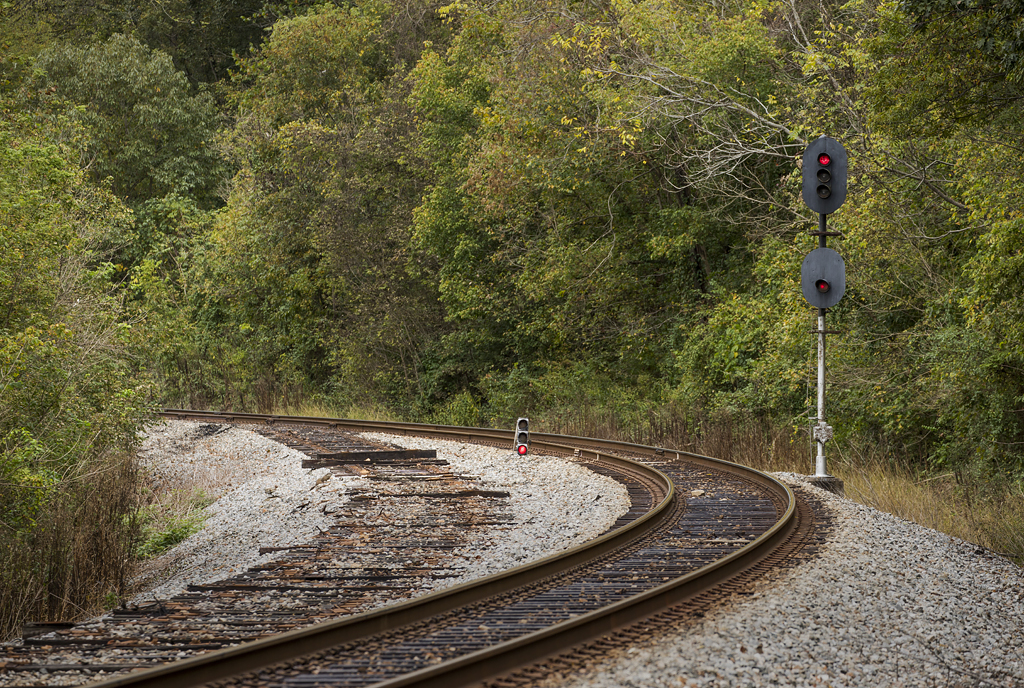
CHARLESTON, W.Va. — Seldom-used rail sidings and excess segments of double track are under review in coal country as CSX Transportation assesses its needs to handle coal traffic. In the past few months, the railroad’s engineering forces have taken a close look at infrastructure in the central Appalachian coalfields served by its former Chesapeake & Ohio lines.
Multiple sections of double-track main line are out of service between Russell, Ky., and Hinton, W.Va., on the railroad’s Kanawha and New River subdivisions. Dispatchers schedule train meets at double-track control points as if the railroad was single track. In the famed New River Gorge, both eastbound and westbound trains use only one track, rather than operating on both the north and south tracks. On coal branches, crews have physically removed sidings, and surplus yard tracks are also being torn up with rail and materials going elsewhere for reuse or scrap.
Simply put, infrastructure in coal country is overbuilt for the needs of today’s coal business. Maintaining sidings at locations where trains meet infrequently costs labor and materials, and sidings built for shorter trains have less use as CSX focuses on fewer but longer trains, one of the basic tenets of Precision Scheduled Railroading. And with overall train counts down, there is no longer a need for hundreds of miles of double track.
Maintaining that capacity is difficult to justify with coal volumes continuing to fall. CSX reported 180,000 coal carloads in the third quarter of 2021. That’s an average of 2,000 carloads per day, a drop of more than 50% since the third quarter of 2011, when the railroad handled more than 386,000 carloads of coal, or more than 4,200 per day. With coal’s future centered primarily around the metallurgical market, those volumes will continue to fall as additional coal-fired power plants close or convert to natural gas.
For the first time since coal’s initial decline, railroads like CSX are making relatively permanent decisions to reduce their network in response to long-term trends. Arguably, the decision to trim assets isn’t shortsighted, but a well-thought out strategic decision that could have happened pre-PSR without any real impact to velocities.
Expect more thoroughly examined changes as CSX, Norfolk Southern, and other coal-dependent railroads figure out what they need to serve the coal business.














CSX abandoned the former B&O mainline across southern Ohio from Parkersburg to Cincinnati, then I seem to recall that they wished they had it back. Someone correct me if I’m wrong on the second part.
Keep in mind that one of the drivers for _extending_ the use of coal was grandfathering in existing plants & allowing looser standards for emissions for them. Those exceptions are gone.
On top of it, back 2018/2019 MMBtu costs for Ng were already 50%-100% higher.
They ain’t going back to coal for generating electricity.
The Utilities will sell their first-born down the river for 5-cents per hundredweight. Fuel is their largest expense, and they will shift fuels in a NY Minute.
Make no hasty moves with plant. Mothball, perhaps, but not remove.
The railroads made the same mistake between 1950 and 1980, just before the demand for passenger service and increasing freight was on the rise. Back then, a lot of the ROWs were sold to private interests, eliminating future opportunities for restored routes (it’s always easier to restore what’s still there). Mark my words: PSR is not forever, right now it’s a thing. The railroads will need those defunct roadways one day.
Is this the opportunity to reconfigure lines for different and probably faster traffic?
As noted by some of the earlier posts, CSX and NS should proceed with caution on downsizing the tracks and sidings serving the coal industry. Oil, gas and coal prices vary and if the price of oil and gas continue to increase coal may become more competitive and demand for rail service will increase. Even though the energy markets are trying to move away from carbon based fuels to generate electricity, coal will be a required back up for years to come. I also read where China is still increasing the use of coal to generate electricity so the export market may continue to grow. As a CSX stockholder I hate to see cuts that may cause lower profits long term. This trend to grow profits at the expense of cutting capacity is a short term road to lower long term profits.
Meanwhile, back at the energy ranch, Natural Gas prices have about doubled in the last 6 months. When the price of coal vs gas becomes a little more on an even playing field, who’s going to ship the coal when the tracks are gone?
Not anymore.
https://oilprice.com/ Down today 1.13% to 3.771, been dropping markedly for a couple weeks now.
We all know how this will play out. Engineering will run simulations and determine they can remove x miles of 2nd main and y number of sidings on the branches and still get the work done smoothly. Then the ivory tower will order 2x of 2nd main removed and 3y number of sidings removed to “save even more.” Dysfunction will be the inevitable result and they will spend 3 times the projected savings in additional operating costs. Let the finger-pointing begin.
John, it would make sense if CSX and NS consolidated track in coal country. Empty westbounds could go up the steeper N&W, while loaded eastbounds could go down the gentler C&O. The Newport News coal docks could be closed in favor of the much lager Lambert’s Point in Norfolk. Coal trains coming off the C&O would have to go over the ACL between Richmond and Petersburg, then down the N&W to Norfolk. Call it Coalfield Shared Assets!
I wonder if there are possible NS-CSX track sharing consolidations that would facilitate infrastructure reductions in coal country?